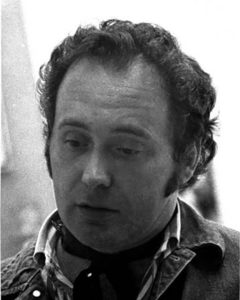
The artist was born Robert Clark, and later adopted the name of his home state. One of his most famous works is the “Love” sculpture. Photo courtesy of Indiana Historical Society.
(Sep. 13, 1928 – May 19, 2018). Adopted at birth in New Castle, Indiana, by Earl and Carmen Clark of Indianapolis, Robert was raised in 21 places around the capital city before graduating valedictorian of the class of 1946 at Arsenal Technical High School. Because he moved so many times as he grew up, the artist said that the jumble of addresses engendered his constant fascination with the numerals 0 through 9 as an artistic motif.
Eschewing a scholarship to the local Herron Art Institute, Indiana enlisted in the U.S. Air Force to benefit from the G.I. Bill, which he used at the School of the Art Institute of Chicago. He settled in New York in 1954, associated with aspiring artists such as Ellsworth Kelly and Andy Warhol, and adopted the name “Indiana” in the manner of popular playwright Thomas Lanier “Tennessee” Williams and of Italian Renaissance artists who were known by their places of origin.
Indiana became a leader of the nascent Pop movement when in 1961 he sold to the Museum of Modern Art his American Dream I, a painting composed of road signage and jukebox imagery conjured up from his vagabonding boyhood. His LOVE, which appeared in paintings in 1966, was uncopyrighted and therefore widely appropriated, becoming an emblem of the “Love Generation.” While its free usage perpetually irked Indiana, LOVE became his icon, and he reiterated the composition in an array of paintings, screen prints, stamps, and sculptures in various sizes, colors, and languages.
Indiana’s works are included in the collections of such important museums as the Museum of Modern Art, the Whitney Museum of American Art, the National Gallery of Art, the Hirshhorn Museum and Sculpture Garden, and the Smithsonian Museum of American Art. The first retrospective exhibition of his work took place at the Whitney Museum of Modern Art in 2013.
Critical neglect of his new work drove Indiana into self-imposed exile from New York in 1978 to the island of Vinalhaven off the Maine coast where he worked in isolation for the last 40 years of his life.
Martin Krause
Curator emeritus
Indianapolis Museum of Art at Newfields

